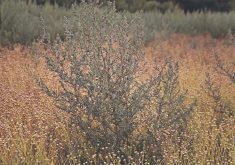High fibre, low cholesterol
This will be my last column for awhile. We will be leaving for Arizona in a few days and will return the first of April. Here’s hoping the weather will not be too cold for all of you left behind.
High-fibre cookies
S.A. wrote requesting a cookie recipe with lots of fibre, similar to one she buys that has 11.32 grams of fibre in a 25-gram cookie. We were unable to find any recipes that would have anywhere near this much fibre. This recipe for carrot cookies has several high-fibre ingredients and the fibre per 25 gram cookie would be 0.62 grams. By adding one cup (250 mL) of bran to the recipe, each cookie would then be 1.07 grams.
Read Also

Kochia has become a significant problem for Prairie farmers
As you travel through southern Saskatchewan and Alberta, particularly in areas challenged by dry growing conditions, the magnitude of the kochia problem is easy to see.
Carrot cookies
1Ú2 cup margarine 125 mL
1 cup brown sugar 250 mL
2 eggs 2
1 cup grated carrot 250 mL
11Ú2 cups whole wheat 375 mL
flour
2 tsp. baking powder 10 mL
1Ú4 tsp. baking soda 1 mL
1 tsp. salt 5 mL
1 tsp. cinnamon 5 mL
1 tsp. nutmeg 5 mL
1Ú2 cup quick-cooking 125 mL
rolled oats
1 cup raisins 250 mL
Cream margarine with brown sugar. Beat in eggs. Stir in carrots. Add dry ingredients and raisins. Drop mixture from heaped tablespoon on greased baking sheet. Bake at 350 F (180 C) for 15-20 minutes.
Eating several different high-fibre foods at different times of the day would achieve the same goal as getting a lot of fibre all at once from one food. It was suggested to us that this approach would be easier on the digestive system. Some high-fibre foods could be eaten alone or mixed in and added to other dishes.
Among the highest fibre-containing foods are one cup each of:
cooked lentils 8.4 g
cooked chickpeas 6.1 g
red kidney beans 6.7 g
cooked split peas 4.8 g
cooked beans, snap green
or yellow, 3.4 g
broccoli, boiled and drained 4.0 g
corn, sweet, canned,
cream style 7.6 g
mushrooms pieces 4.1 g
potatoes, baked in skin,
12 cm long 4.6 g
tomatoes, canned 4.0 g
dried apricots 11.1 g
wheat bran 19.2 g
wheat flour, whole 11.3 g
Source: Nutrient Value of Some Common Foods, Health Canada, 1995.
Easy breakfast
During the holidays, we were introduced to nest eggs when sister-in-law Irene served them for breakfast on New Year’s morning. She discovered the recipe in The Best Of The Best and More, written and published in 1998 by the Best of Bridge Publishing Ltd.
Scotty’s nest eggs
Each nest:
2-3 slices Black 2-3
forest ham
1 egg 1
1 tbsp. cream 15 mL
1 heaping tbsp. 25 mL
grated Swiss cheese
sprinkle of dried basil
English muffin or toast
Preheat oven to 350 F (180 C). Grease large muffin tins. Line with ham and break egg over top. Add cream and sprinkle with cheese and basil. Place water in any unused muffin cups to prevent damage. Bake 15-20 minutes. Serve on half a toasted English muffin or on toast.
Dealing with cholesterol
Dear TEAM: I would like to see a page of recipes for those who are on a diet to reduce cholesterol. I was thrilled to see the poem “A little girl sat under a tree” as I said that poem many years ago. Thank you for your help. – J.T., Fort Nelson, B.C.
Dear J.T.: Rather than a page of recipes I thought it might be more helpful to have suggestions for adapting the recipes you now enjoy.
The most important thing is to cut back on the total amount of fat in our diet. Omit foods high in fat, or if you do not want to completely give up the food, use less.
- When cooking, use less or no fat. Use a nonstick skillet and add water rather than fat when items start to stick to the bottom of the pan.
- Flavor cooked vegetables with basil, thyme, dill, parsley or other fresh herb, rather than butter.
- Choose lower fat dairy products for baking, cooking and drinking. Low-fat cheeses, sour cream and cottage cheese can almost always be substituted for their regular counterparts. Yogurt can make a perfect substitute for sour cream as a topping on soups, potatoes or perogies.
- Traditional vinaigrette and salad dressings may have as much as four parts oil to one part vinegar. For most recipes you can simply change that proportion to one part oil to one part vinegar. The result will be an even tastier dressing.
One example is this vinaigrette recipe from Lighthearted Everyday Cooking by Anne Lindsay, published by Macmillan of Canada, 1991.
Everyday vinaigrette
2 tbsp. oil 30 mL
2 tbsp. lemon juice or 30 mL
rice, cider or
balsamic vinegar
2 tbsp. water 30 mL
1 small clove 1
garlic, minced
1 tsp. Dijon mustard 5 mL
pinch each salt and pepper
In a small measuring cup, bowl or jar with screw top, combine oil, lemon juice or vinegar, water, garlic, mustard, salt and pepper; mix well.
Variations: Add one of the following to the dressing: one teaspoon (five mL) sesame oil; 1Ú4 teaspoon (one mL) cumin; one tablespoon (15 mL) freshly grated parmesan cheese.
Herb dressing: Add two tablespoons (30 mL) chopped fresh herbs (basil, dill, parsley or a combination).
Poppyseed dressing: Omit mustard and garlic. Add one tablespoon (15 mL) poppyseeds and one teaspoon (five mL) granulated sugar.
Ginger-garlic dressing: Use one tablespoon (15 mL) each of vegetable oil and sesame oil; add one teaspoon (five mL) finely minced fresh ginger root, omit mustard.
As well as reducing our total fat intake we can choose fats low in saturated fats.
One suggestion is to bake with canola oil. Substituting canola oil for butter, lard or brick margarine replaces fats high in saturated fatty acids with an oil that has the lowest level of saturated fatty acids. Further, substituting oil for solid fats reduces the quantity of oil by 20 percent, which in turn reduces total fat intake.
Substituting canola oil does modify the texture, usually making the baked product softer and more moist. This is usually a desirable characteristic for muffins, cakes and loaves. It’s even possible to make pastry with canola oil.
Canola oil pastry
13Ú4 cups all- 425 mL
purpose flour
1 tsp. salt 5 mL
1Ú2 cup canola oil 125 mL
3-4 tbsp. ice water 45-60 mL
Measure flour and salt into bowl. Add canola oil. Mix together until particles are the size of small peas.
Sprinkle with water, one tablespoon (15 mL) at a time, mixing until flour is moistened and dough almost lifts from the side of the bowl. If dough seems dry, add more oil, not water.
Yield: two 9 inch (22 cm) shells.
Canola pastry is to be used immediately as it dries quickly. If the pastry is not used immediately, wrap tightly and keep chilled.
Conversion chart: Use the following chart to convert recipes from solid fat to oil:
Solid fat Canola oil
1 cup (250 mL) = 131Ú2 tbsp. (202.5 mL)
3Ú4 cup (187.5 mL) = 10 tbsp. (150 mL)
1Ú2 cup (125 mL) = 7 tbsp. (105 mL)
1Ú4 cup (62.5 mL) = 31Ú2 tbsp. (52.5 mL)
For additional canola oil information, contact: Dorothy Long, Canola Information Service, Box 1645, Lloydminster, Sask., S9V 1K6 Phone: 306-387-6610; fax: 306-387-6637; e-mail: canola@sk.sympatico.ca; website: www.canolainfo.org.














